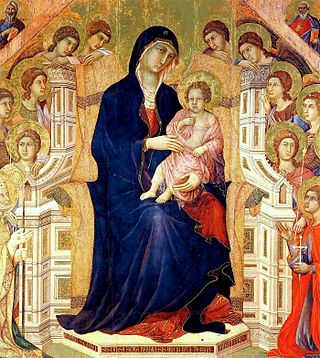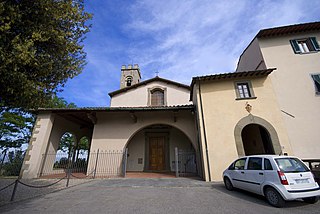Related Research Articles

Duccio di Buoninsegna, commonly known as just Duccio, was an Italian painter active in Siena, Tuscany, in the late 13th and early 14th century. He was hired throughout his life to complete many important works in government and religious buildings around Italy. Duccio is considered one of the greatest Italian painters of the Middle Ages, and is credited with creating the painting styles of Trecento and the Sienese school. He also contributed significantly to the Sienese Gothic style.

Lorenzo di Pietro, known as Vecchietta, was an Italian Sienese School painter, sculptor, goldsmith, and architect of the Renaissance. He is among the artists profiled in Vasari's Le Vite delle più eccellenti pittori, scultori, ed architettori.

Domenico di Bartolo, born in Asciano, Siena, was a Sienese painter of the early Renaissance period. In the Lives of the Most Excellent Painters, Sculptors, and Architects, Giorgio Vasari says that Domenico was the nephew of Taddeo di Bartolo. Influenced by the new Florentine style of painting, Domenico di Bartolo was the only Sienese painter of his time to receive commissions from clients in Florence. In Siena, he was employed by Lorenzo di Pietro, to help execute the fresco The Care of the Sick, in the Pilgrim's Hall of the Hospital of Santa Maria della Scala.

Taddeo di Bartolo, also known as Taddeo Bartoli, was an Italian painter of the Sienese School during the early Renaissance. His biography appears in the Vite of Giorgio Vasari, who claims that Taddeo was the uncle of Domenico di Bartolo.

Greve in Chianti is a town and comune (municipality) in the Metropolitan City of Florence, Tuscany, Italy. It is located about 31 kilometres (19 mi) south of Florence and 42 kilometres (26 mi) north of Siena.

Radda in Chianti is a comune (municipality) in the Province of Siena in the Italian region Tuscany, located about 35 kilometres southeast of Florence and about 15 km north of Siena.

The Basilica of San Domenico, also known as Basilica Cateriniana, is a basilica church in Siena, Tuscany, Italy, one of the most important in the city. The basilica is an example of Cistercian Gothic style.

Tuscan wine is Italian wine from the Tuscany region. Located in central Italy along the Tyrrhenian coast, Tuscany is home to some of the world's most notable wine regions. Chianti, Brunello di Montalcino and Vino Nobile di Montepulciano are primarily made with Sangiovese grape whereas the Vernaccia grape is the basis of the white Vernaccia di San Gimignano. Tuscany is also known for the dessert wine Vin Santo, made from a variety of the region's grapes. Tuscany has forty-one Denominazioni di origine controllata (DOC) and eleven Denominazioni di Origine Controllata e Garantita (DOCG). In the 1970s a new class of wines known in the trade as "Super Tuscans" emerged. These wines were made outside DOC/DOCG regulations but were considered of high quality and commanded high prices. Many of these wines became cult wines. In the reformation of the Italian classification system many of the original Super Tuscans now qualify as DOC or DOCG wines but some producers still prefer the declassified rankings or to use the Indicazione Geografica Tipica (IGT) classification of Toscana. Tuscany has six sub-categories of IGT wines today.

The history of Chianti dates back to at least the 13th century with the earliest incarnations of Chianti as a white wine. Today this Tuscan wine is one of Italy's most well known and recognizable wines. In the Middle Ages, the villages of Gaiole, Castellina and Radda located near Florence formed as a Lega del Chianti creating an area that would become the spiritual and historical "heart" of the Chianti region and today is located within the Chianti Classico Denominazione di Origine Controllata e Garantita (DOCG). As the wines of Chianti grew in popularity other villages in Tuscany wanted their lands to be called Chianti. The boundaries of the region have seen many expansions and sub-divisions over the centuries. The variable terroir of these different macroclimates contributed to diverging range of quality on the market and by the late 20th century consumer perception of Chianti was often associated with basic mass-market Chianti sold in a squat bottle enclosed in a straw basket, called fiasco.

Siena is a city in Tuscany, Italy. It is the capital of the province of Siena. Siena is the 12th largest city in the region by number of inhabitants, with a population of 53,062 as of 2022.

San Niccolò al Carmine, also called Santa Maria del Carmine is a Renaissance style, Roman Catholic church and monastery located in Pian dei Mantellini #30, near the corner of Via della Diana in the Terzo de Citta of Siena, region of Tuscany, Italy. The church now serves as the Oratory for the Contrada of Pantera. Across the street from the belltower is the Palazzo Celsi Pollini. North along Pian dei Mantellini, toward the Arco delle Due Porte, and on the same side of the street are a number of palaces built around what was once the Monastery of the Derelict Women: in order they are the Neoclassical Palazzo Incontri, the Palazzo Ravissa and the Palazzo Segardi.
The Oratory of the Compagnia di Santa Caterina della Notte is a highly decorated prayer hall present in the top floor of the medieval Hospital of Santa Maria della Scala in Siena, region of Tuscany, Italy.

Cenni di Francesco di ser Cenni was an Italian Gothic painter active in Florence between 1369/1370 and 1415. His only signed work is the fresco of the True Cross at the Cappella della Croce di Giorno at the church of San Francesco in Volterra, painted in 1410. A couple of dozen works have been attributed to Cenni di Francesco on the basis of a similarity of style with the fresco.
Meo di Pero, also called Meo di Piero was an Italian painter active in Siena in a Gothic style. He worked in the studio of Cristoforo di Bindoccio. All the latter paintings are generally co-attributed to Meo, since no independent work is known.

The Certosa di Pontignano, also known as the Certosa di San Pietro, is a Carthusian monastery and church in the neighborhood of Pontignano, within the town limits of Castelnuovo Berardenga, a few kilometers north of the city of Siena, in the region of Tuscany, Italy. The monastic complex, after the expulsion of the monks in 1810, passed through various hands, until it was acquired in 1959 by the University of Siena, and used for academic meetings, conventions, and also hotel and restaurant for events such as weddings and celebrations.

Cesare Maffei was an Italian painter of the Neoclassical period, active in Tuscany.
The Diocesan Museum of Sacred Art (MuDAS) in Arezzo was founded in 1963 but opened regularly to the public only in 1985, and was housed in several rooms above the sacristy of the Cathedral of San Donato. In 2011 it was relocated to the first floor of the bishop's residence. The museum exhibits works of art and liturgical items, from the 12th to the 19th centuries, that come from the cathedral and other churches in the diocesan territory, significant for their religious and cultural significance to Arezzo and the surrounding area. Highlights of the museum include several works of Giorgio Vasari and the Pace di Siena.

Saint Dominic in Soriano was a portrait of Saint Dominic (1170–1221) painted in 1530. It is an important artefact in the Dominican friary at Soriano Calabro in southern Italy. It was believed to be of miraculous origin, and to inspire miracles. It was the subject of a Roman Catholic feast day celebrated on 15 September from 1644 to 1913. Its miraculous origin was the subject of several 17th-century paintings. Several ecclesiastical buildings have been named after it.

San Martino a Gangalandi is a Roman Catholic parish (pieve) church in the Gangalandi neighborhood of Lastra a Signa in the region of Tuscany, Italy. It is located via Leon Battista Alberti. Adjacent to the church is a small Museo Vicariale displaying some works of art.

Chianti, in Italy also referred to as Monti del Chianti or Colline del Chianti, is a mountainous area of Tuscany in the provinces of Florence, Siena and Arezzo, composed mainly of hills and mountains. It is known for the wine produced in and named for the region, Chianti.
References
- ↑ Piccoli Grandi Musei, short biography and collections in Museo San Domenico.
- ↑ "Image of Saint Dominic Being Carried to Soriano by the Madonna and the Saints Mary Magdalene and Catherine". Piccoli Grandi Musei. Retrieved 17 April 2017. (Under the 'Collection' tab.)